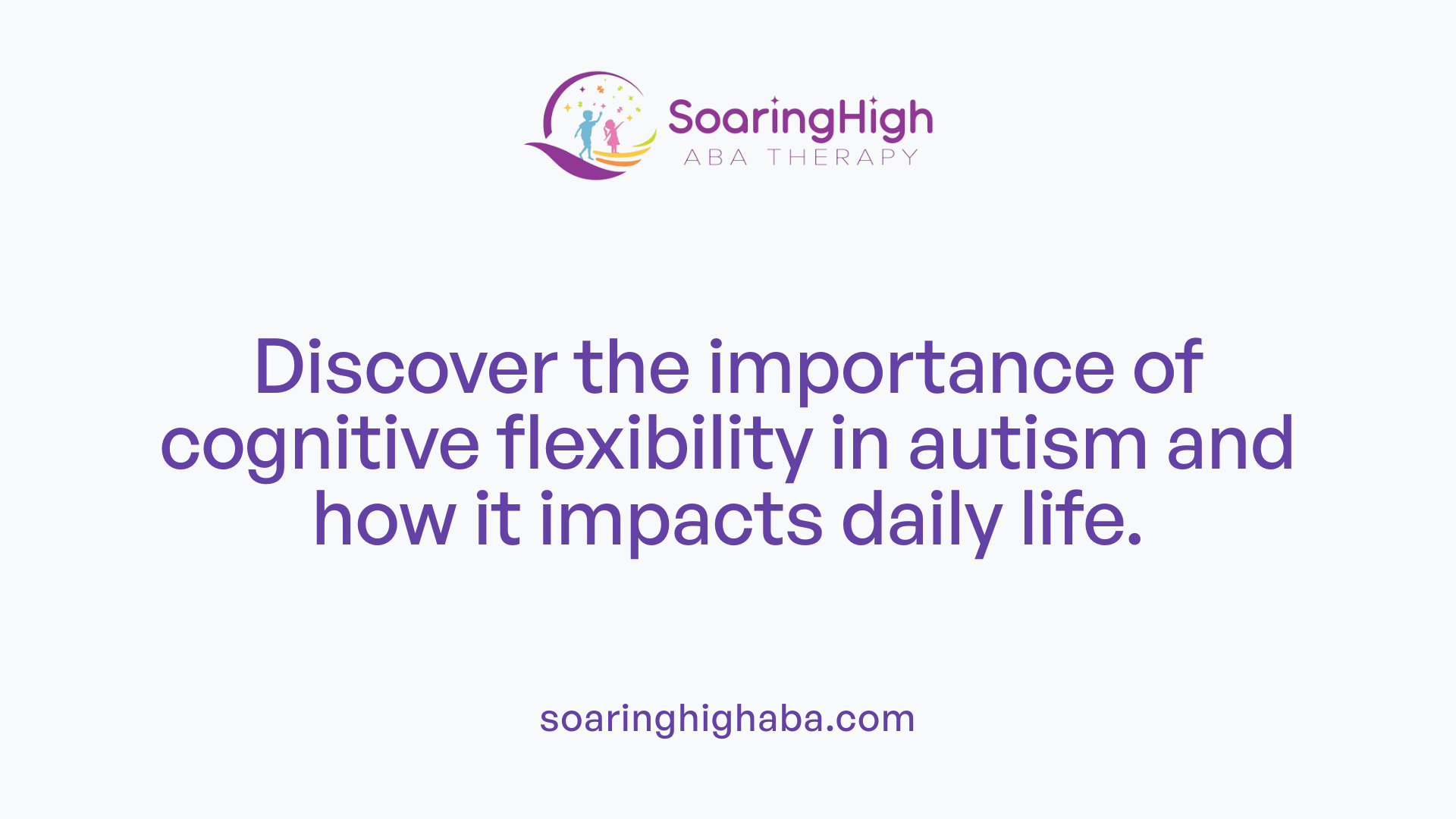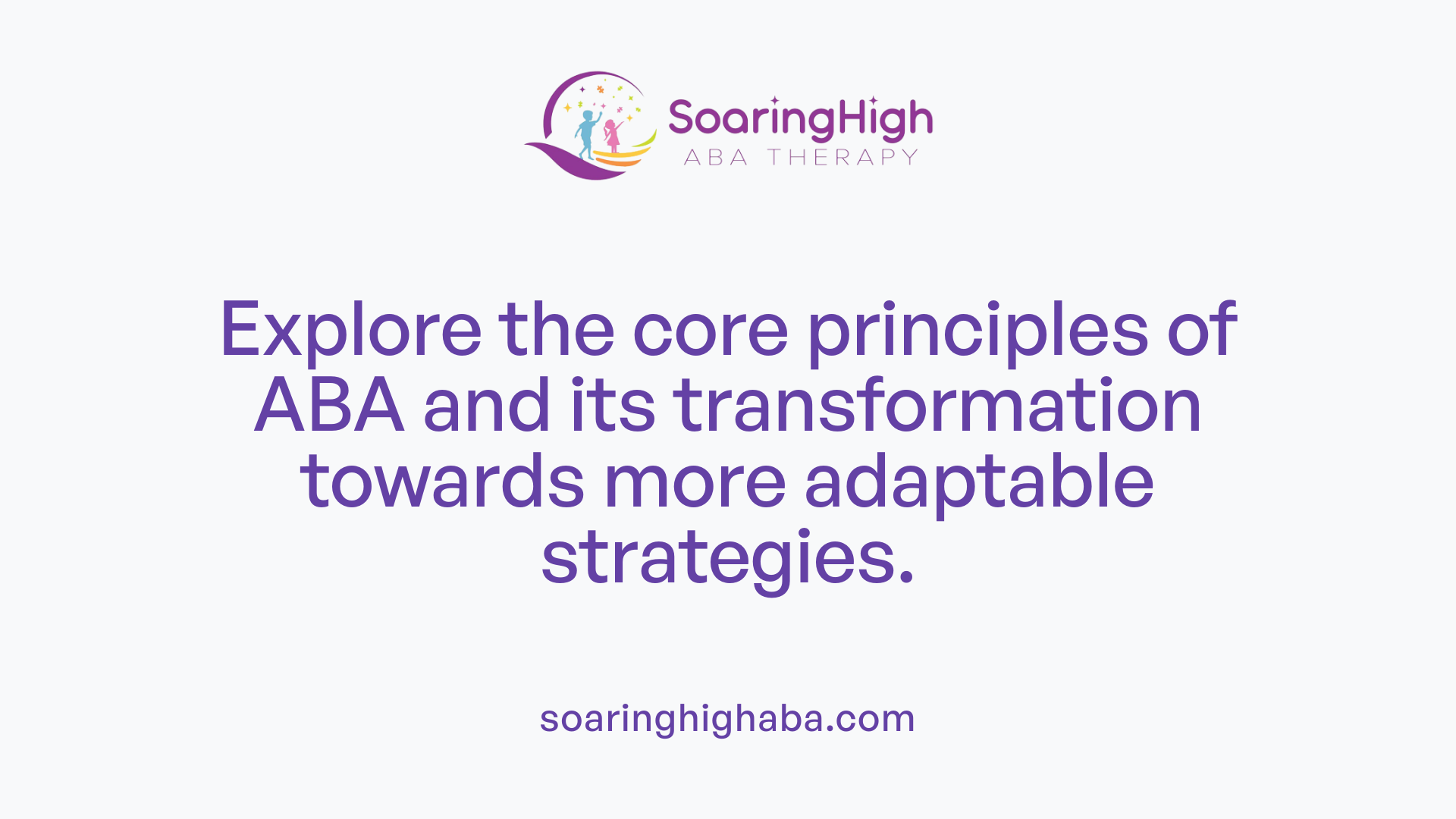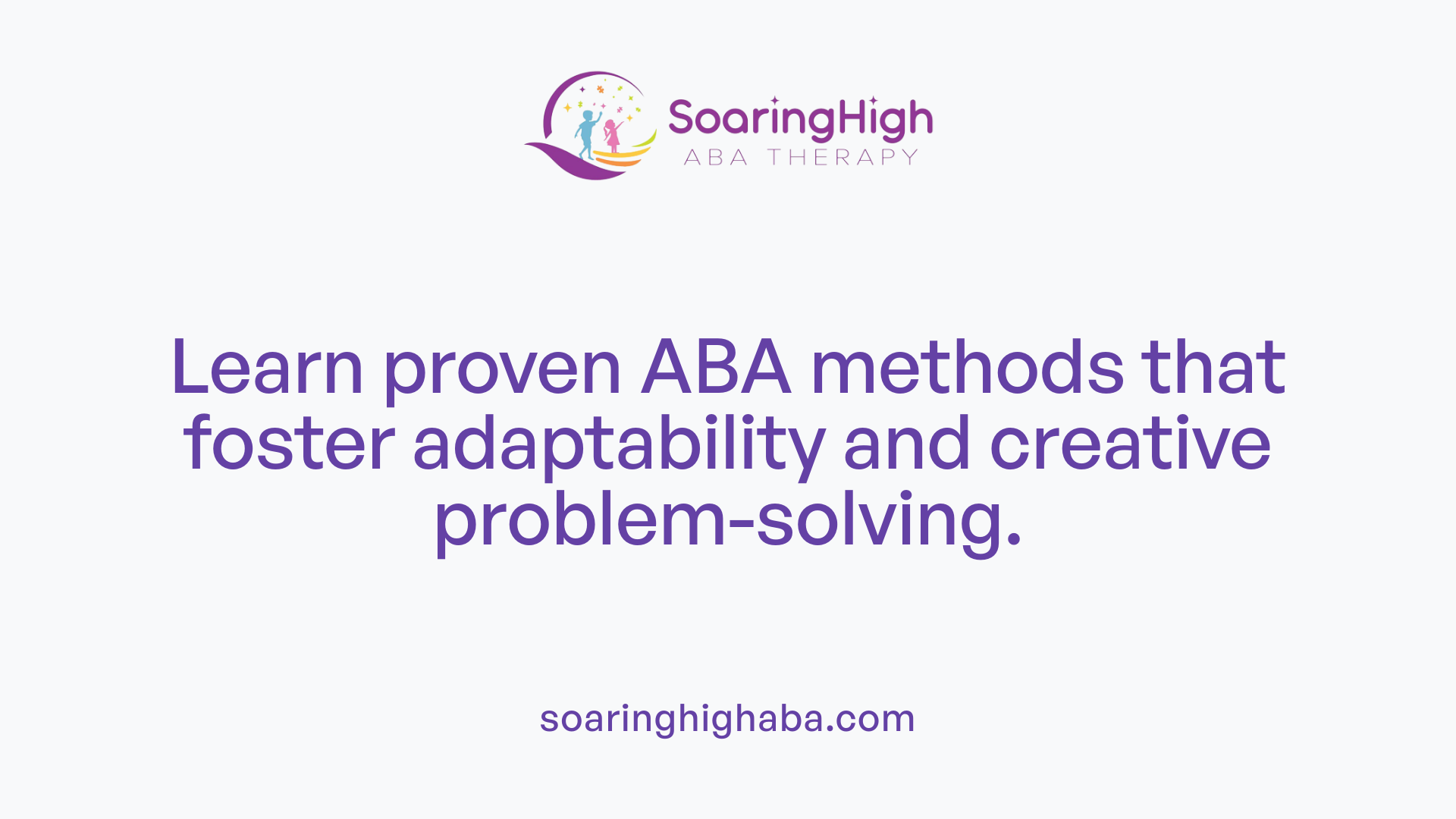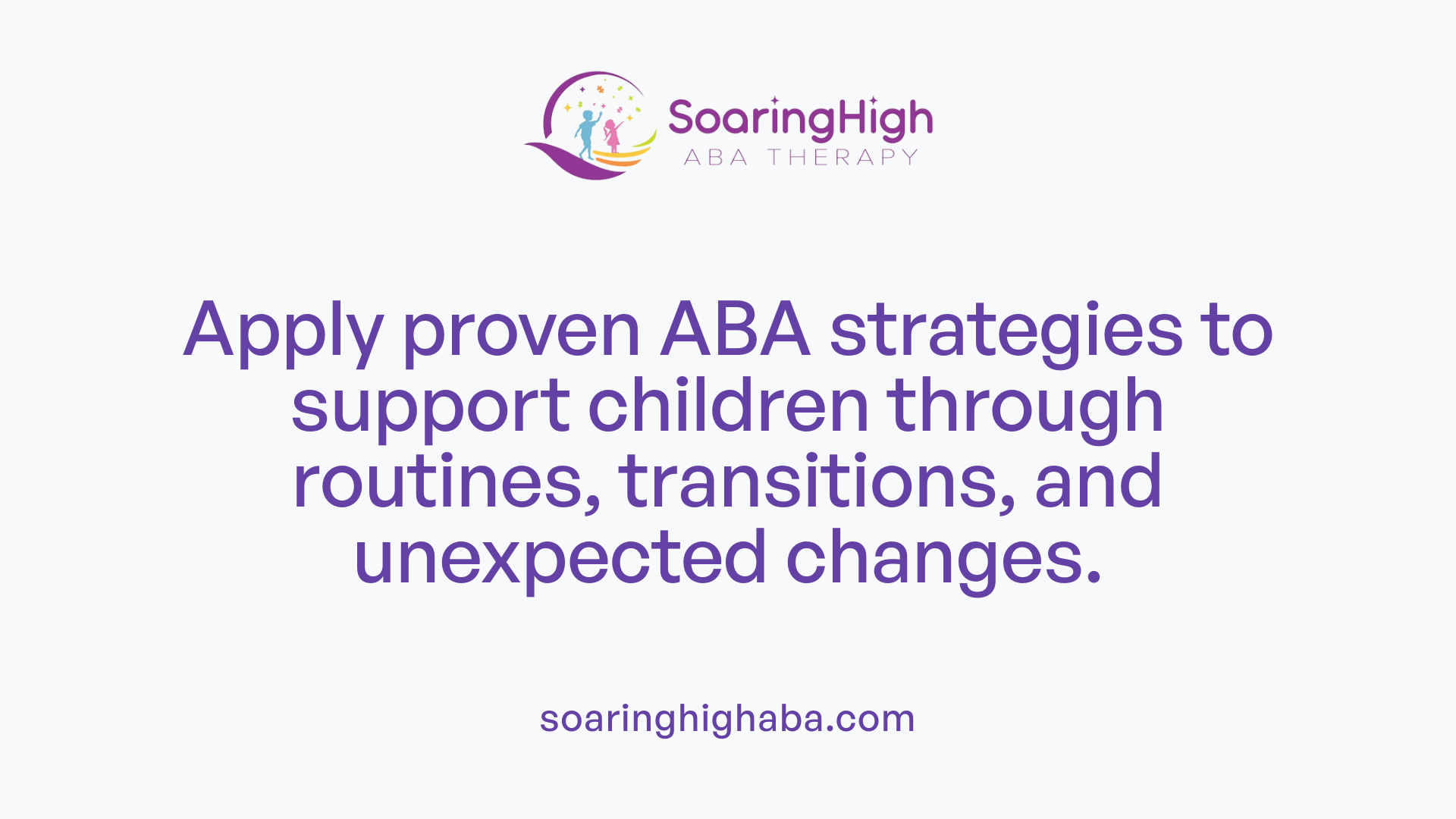Enhancing Adaptability in Children with Autism Using ABA Therapy
Cognitive flexibility, or the ability to adapt behaviors and perspectives, is crucial for children with autism to thrive in social, academic, and everyday settings. ABA therapy, an evidence-based approach, has evolved from rigid methods to more flexible, personalized strategies aimed at encouraging adaptable thinking. This article explores how modern ABA techniques can cultivate flexible thinking, the benefits of increased flexibility, and practical strategies for parents and practitioners.
Understanding Flexibility in Autism and Its Significance

What is cognitive flexibility in autism?
Cognitive flexibility refers to the ability to adapt behaviors, switch between tasks, and see situations from different perspectives. In children with autism, challenges in this area often manifest as difficulty accepting new ideas, trouble changing routines, or increased anxiety when plans unexpectedly shift. Traditional ABA approaches might emphasize strict routines and memorization, which can limit these children’s capacity to develop flexible thinking.
To promote cognitive flexibility, interventions such as game-based learning, role modeling, and gradual exposure to change are employed. These strategies help children learn to adapt to new circumstances, reduce stress associated with unpredictability, and foster the ability to approach problems with different solutions.
Signs of rigidity in children with autism
Signs of rigidity include repetitive behaviors, resistance to change, over-reliance on prompts, and limited spontaneity. For example, a child may become distressed if a routine is disrupted, or they may insist on doing activities in a specific way.
Such rigidity can hinder the development of real-life skills, as children struggle to adapt to new environments or unexpected circumstances. Recognizing these signs early allows caregivers to implement strategies that promote flexibility, such as modifying routines gradually or teaching problem-solving skills.
How does rigidity impact development?
Rigid thinking can have several negative impacts on a child's development. It limits the ability to generalize skills learned in structured settings to real-world environments. For example, a child might excel in structured tasks but find it difficult to apply those skills when circumstances change.
This can lead to increased anxiety and stress, especially when routines are broken or new situations arise. Over time, rigidity may also interfere with social skills development, as children might struggle to engage with peers or navigate social cues.
Research indicates that fostering flexibility helps mitigate these challenges. Techniques like frontloading information before change, using visual supports such as calendars or change boards, and practicing small, incremental adjustments can aid children in becoming more adaptable.
| Aspect | Behavior or Effect | Strategies to Improve Flexibility |
|---|---|---|
| Cognitive Flexibility | Difficulty switching tasks or perspectives | Role modeling, games promoting flexibility, problem-solving tasks |
| Anxiety and Stress | Increased anxiety during change | Visual supports, gradual routine modifications, reassurance |
| Social Interaction | Limited social engagement and spontaneity | Social skills training, modeling flexible behaviors |
| Skill Generalization | Challenges applying skills in different settings | Practice in natural environments, incidental teaching |
Building cognitive flexibility is a vital component of effective autism support. It enables children to handle everyday changes confidently, participate more fully in social and learning activities, and develop resilience. Using evidence-based methods like shaping, incidental teaching, and pivotal response training, therapists and caregivers can help children move beyond rigidity toward enhanced adaptability and emotional well-being.
The Foundations of ABA Therapy and Its Evolving Nature

What are the core principles of ABA?
Applied Behavior Analysis (ABA) is built on principles such as reinforcement, individualized programming, and data collection. Reinforcement involves rewarding desired behaviors to encourage their repetition, while data collection helps track progress and adjust strategies. Programs are tailored to each child's needs, ensuring interventions are personalized. ABA emphasizes structured teaching methods, often involving clear prompts, repetition, and consistency to foster learning.
How does ABA therapy help develop cognitive flexibility in children with autism?
ABA therapy enhances cognitive flexibility by implementing structured interventions that aim to improve adaptive thinking, problem-solving, and response shifting. Techniques like shaping and incidental teaching promote flexible responses in daily situations. Reinforcing behaviors that involve switching tasks or perspectives supports adaptability. Some programs incorporate social communication skills, fostering the ability to respond flexibly in interactions. Furthermore, mindfulness and emotional regulation strategies can be integrated into ABA, helping reduce rigidity.
Assessments such as the Children’s Color Trails Test (CCTT) are used to monitor improvements in set-shifting and attentional control, key indicators of increased flexibility. Through personalized, data-driven plans, ABA helps decrease inflexible behaviors, thereby improving overall daily functioning and reducing anxiety linked to rigidity.
What is the historical context and evolution of ABA therapy?
ABA therapy has been utilized since the 1960s to support children with autism. Originally, it was characterized by strict, structured methods focusing heavily on compliance and repetition. Critics highlighted that early ABA practices sometimes emphasized controlling behaviors over understanding individual needs, occasionally using punishment.
Over time, the approach has evolved significantly. The field now recognizes the importance of flexibility, naturalistic teaching methods, and respecting sensory and emotional needs. Recent developments emphasize positive reinforcement, individualized programs, and the inclusion of behavioral innovations like pivotal response training. This evolution reflects a shift toward more humane, effective, and adaptable therapies.
Rigid versus flexible ABA approaches
Rigid ABA relies on strict adherence to prescribed routines, repetitive drills, and a one-size-fits-all methodology. This can lead to increased anxiety and limited skill generalization, often overlooking the child's sensory and emotional needs. Critics argue that such rigidity may prioritize compliance over well-being.
On the other hand, flexible ABA introduces naturalistic and personalized techniques. It emphasizes spontaneous learning, varied reinforcement, and adapting strategies to each child's interests and environmental context. Incorporating play, social skills training, and real-life scenarios improves generalization and resilience.
Signs of rigidity in ABA include resistance to change, over-reliance on prompts, repetitive behaviors, and limited spontaneity. Conversely, promoting flexibility involves practicing small changes, using visual supports like calendars, creating change boards, and encouraging problem-solving through games and brainstorming.
| Aspect | Rigid ABA | Flexible ABA | Purpose/Effect |
|---|---|---|---|
| Approach | Strict routines | Naturalistic, personalized | Adaptability and generalization |
| Repetition | High | Moderate, varied | Skill transfer to real-life |
| Focus | Compliance | Engagement and spontaneity | Building resilience |
| Techniques | Prompt dependence | Modeling, role-playing | Enhancing social and emotional skills |
In sum, the evolution of ABA reflects a greater understanding of the importance of flexibility, emotional well-being, and personalized approaches to support children with autism more effectively.
The Risks of Rigid ABA and the Shift Towards Flexibility

Detrimental Effects of Rigidity
Rigid ABA therapy often emphasizes strict routines, repetitive behaviors, and memorization. While these strategies can sometimes lead to short-term improvements, they may also limit a child's ability to generalize skills across different settings or situations. Children might become overly dependent on prompts and structured environments, which can hinder their chances of applying learned behaviors in real-life, unpredictable scenarios.
This inflexibility can cause increased anxiety for children who struggle with change. They might become resistant to variation in routines, leading to emotional distress and limiting their social interactions. Furthermore, such rigidity can prevent the development of spontaneous play and communication, crucial for meaningful social engagement.
Criticisms of Traditional ABA
Critics and autism activists argue that traditional, rigid ABA approaches sometimes prioritize compliance over genuine well-being. Many methods involve structured teaching techniques that focus on memorization and behavior conditioning rather than understanding a child's sensory, emotional, and social needs.
Alarmingly, some treatments have included punishment-based strategies, which are harmful and can cause long-term psychological effects. These practices are increasingly challenged by advocates who promote respectful, child-centered approaches that honor individuality and foster positive growth.
Importance of Naturalistic and Personalized Methods
In response to these concerns, a more flexible approach to ABA is gaining popularity. Naturalistic and personalized teaching methods emphasize learning in real-world contexts, encouraging children to develop skills that are relevant and adaptable.
Techniques such as incidental teaching, shaping, and pivotal response training promote cognitive flexibility, social skills, and resilience. These methods involve less reliance on prompts and more focus on child-led activities, making learning more engaging and effective.
Implementing strategies like modeling flexible thinking, using game-based activities, and providing support during unexpected changes helps children with autism navigate their environment more independently. This shift from rigid protocols to more individualized, dynamic approaches aims to improve overall outcomes, including emotional regulation, social interaction, and adaptability.
Effective ABA Techniques for Promoting Flexible Thinking

What techniques and strategies within ABA therapy are effective for encouraging flexible thinking?
ABA therapy is known for its structured, evidence-based approach to helping children with autism develop essential skills. While traditional ABA often emphasizes repetition and strict routines, recent practices focus on fostering cognitive flexibility — the ability to adapt behaviors, switch tasks, and view situations from different perspectives.
One effective method involves explicitly explaining what is happening and what to expect during routines or transitions. Using visual tools like schedules, change boards, and calendars helps children anticipate upcoming changes, reducing anxiety and rigidity.
Incorporating small, manageable changes in daily routines gradually builds tolerance for variability. For example, changing the order of activities or introducing new options during play encourages problem-solving and resilience.
Games and activities are also designed to promote flexible thinking. Pretend play, where objects are used in different ways or game rules are altered, can serve as practical exercises. These activities support children in practicing adaptability in a fun, engaging manner.
Other strategies include frontloading — preparing children beforehand for events or routine changes — and providing reassurance that they are safe, which helps normalize unpredictable situations. Praising children when they successfully demonstrate flexible behaviors reinforces these skills and boosts confidence.
Specific ABA techniques effective for developing flexibility include:
- Discrete Trial Training (DTT): Structured learning with clear, consistent prompts that can be gradually adjusted to incorporate different responses.
- Incidental Teaching: Naturalistic interactions that occur during typical routines, encouraging spontaneous adaptive responses.
- Pivotal Response Training: Focuses on pivotal areas like motivation and self-management to promote broader behavioral improvements, including flexibility.
In sum, combining visual aids, gradual routine modifications, engaging activities, and positive reinforcement creates a supportive environment for children to develop flexible thinking — an essential skill for adaptive, real-life functioning.
Practical Strategies to Cultivate Flexibility During Transitions and Changes

How can ABA therapy be used to foster flexible thinking strategies in children?
ABA therapy offers effective ways to help children develop flexible thinking skills. This approach involves specific interventions that promote adaptability and problem-solving abilities. For example, therapists might introduce routine changes gradually or use social stories that depict various scenarios, helping children understand and prepare for new situations.
One of the main techniques is engaging children in perspective-taking activities, encouraging them to view situations from different angles. Visual supports like schedules and checklists play a crucial role by providing concrete, visual cues about upcoming activities or changes. These tools help children anticipate and understand transitions, reducing anxiety.
Games that involve problem-solving or chance, such as simple decision-making tasks, reinforce flexibility by requiring children to adapt their responses. Repetition and consistent practice with these strategies build confidence. Reinforcing successful flexible behaviors encourages children to apply these skills in real life and across different contexts.
Overall, ABA therapy systematically targets rigid thinking patterns, helping children become more adaptable and resilient. This enhances their ability to navigate daily routines, social interactions, and unexpected changes, leading to greater independence and social success.
The Role of Play, Games, and Self-Help Skills in Building Flexibility
How Do Play-Based Learning and Games Promote Flexibility?
Play is an essential method for developing flexibility in children with autism. Through play-based learning, children encounter unpredictable scenarios, which require them to adapt and think creatively. For example, role-playing or pretend play allows children to practice switching perspectives or modifying their actions based on new situations.
Games that incorporate chance or changing rules are especially effective. These activities teach children to accept new challenges, adapt strategies, and respond flexibly. They often involve problem-solving and decision-making, reinforcing cognitive flexibility in engaging and enjoyable ways.
Why Are Self-Help Skills Important for Flexibility?
Self-help skills, such as dressing, grooming, and organizing personal belongings, also contribute to flexibility. Mastering these skills involves adapting routines and managing unexpected challenges. When children learn to adjust their approach to these daily activities, they become more resilient and capable of handling change in other areas.
Teaching self-help skills in natural contexts helps children become more independent and confident. This, in turn, reduces anxiety around unfamiliar situations and supports overall adaptability.
Practical Strategies to Encourage Flexibility Through Play and Self-Help Skills
- Incorporate games that change rules or involve chance, like board games or improvisation activities.
- Use role-playing to simulate real-life scenarios, encouraging children to think on their feet.
- Gradually introduce small, planned disruptions to routines, such as changing the order of activities.
- Use visual supports like calendars and change boards to prepare children for upcoming modifications.
- Encourage children to brainstorm solutions during play, fostering problem-solving and adaptability.
Integrating these play and self-help activities into daily routines boosts cognitive flexibility. This approach helps children with autism become more adaptable, resilient, and confident in managing everyday changes.
Building Resilience and Confidence Through Praise and Reassurance
How does reinforcement of flexible behaviors help children with autism?
Reinforcing flexible behaviors is essential to encouraging children with autism to adapt to new situations and routines. When children successfully demonstrate flexibility, such as adjusting to a change in plans or trying a new activity, providing positive reinforcement boosts their motivation to continue these behaviors. Rewards like praise, stickers, or preferred activities serve as tangible acknowledgments of their efforts, making them more likely to practice flexibility in future situations.
This reinforcement not only promotes immediate behavioral change but also helps build a foundation for resilience. Over time, children learn that adapting to change can lead to positive outcomes, reducing the resistance and anxiety often associated with unpredictability.
How can praise and encouragement foster confidence and reduce anxiety?
Praise and encouragement are powerful tools in supporting children through transitions and unexpected changes. When children receive specific praise, such as “Great job trying something new!” or “I like how you stayed calm during the change,” it reinforces their effort and success.
Such positive comments help children feel competent and supportive, which builds their confidence. Increased confidence decreases feelings of fear or anxiety about new or challenging situations. Encouragement also communicates emotional safety, assuring children that making efforts to be flexible is valued and appreciated.
What strategies can reduce anxiety during transitions?
Reducing anxiety during routine changes is crucial for developing resilience. Tools like visual supports—using calendars and change boards—prepare children for upcoming events, making changes less sudden and more predictable.
Introducing small, manageable modifications gradually—such as changing the order of activities or trying new ways of playing—helps children practice flexibility without overwhelming them. Explaining upcoming changes clearly and explicitly, and reassuring children about their safety, further support emotional regulation.
Games that involve chance or variation, like changing rules or pretending objects are different items, also encourage flexible thinking while making transitions fun and less stressful. Ultimately, combining these strategies with praise when children succeed fosters a positive environment where flexibility is seen as achievable and rewarding.
Summary and Future Directions for Promoting Flexibility in Autism
How does rigid ABA therapy impact children with autism?
Rigid ABA therapy often resembles following a strict recipe, emphasizing consistent repetition and structure at the expense of the child's individual needs. This approach can limit the ability of children to generalize skills to real-world settings, increase their anxiety, and hinder the development of social skills.
What are the drawbacks of rigid ABA techniques?
Focusing mainly on structured teaching and memorization can prevent children from applying learned skills spontaneously and in varied environments. This rigidity may neglect sensory and emotional needs, potentially leading to increased stress and decreased engagement for the child.
Why do critics oppose strict ABA practices?
Many critics and activists argue that some rigid ABA practices prioritize compliance over the child's well-being. They highlight concerns about punishment-based techniques and emphasize that such methods can be harmful and counterproductive.
What alternatives are emerging in ABA therapy?
Flexible ABA approaches are gaining popularity, emphasizing naturalistic, personalized teaching methods. These methods aim to improve not just skills but also adaptability, social interactions, and emotional wellbeing.
What does research say about effective ABA techniques?
Evidence-based strategies like shaping, incidental teaching, and pivotal response training have shown promising results. They foster flexible thinking and enhance overall success for children with autism.
How can rigidity in ABA be identified?
Signs include repetitive behaviors, resistance to change, over-reliance on prompts, and limited spontaneity. Recognizing these signs helps tailor interventions to better promote natural development.
Why is cognitive flexibility important?
Psychological flexibility, especially cognitive flexibility, enables children with autism to adapt to new situations, reduce stress, and improve social skills. Interventions such as play activities, games, and social interactions support this development.
What strategies encourage flexible thinking?
Strategies include modeling flexibility, introducing games, creating supportive environments, and using solution-focused approaches. These practices help children build resilience, problem-solving skills, and confidence.
How does positive reinforcement influence therapy?
Providing rewards and positive feedback encourages desired behaviors, making learning more effective. Consistency, variety, and tailoring reinforcements to interests are essential for success.
How does ABA support social and emotional development?
ABA therapy helps children understand social cues, share, take turns, and regulate emotions. It also contributes to academic gains, such as vocabulary growth and problem-solving.
Strategies for fostering flexibility in daily routines
Practical methods include changing routine orders, introducing new activities, preparing children for changes using visual tools like calendars and change boards, and playing flexible games. These approaches help reduce anxiety and promote adaptability.
Future outlook for promoting flexibility in autism
Future research and strategies focus on enhancing naturalistic, individualized techniques that support cognitive flexibility. Improving methods to manage anxiety and sensory challenges will further empower autistic individuals to thrive in diverse environments.
Empowering Children with Autism to Adapt and Grow
By embracing flexible and personalized ABA strategies, practitioners and caregivers can significantly enhance the cognitive flexibility of children with autism. Such development leads to better social skills, reduced stress, and increased independence. Ongoing research and adaptation of techniques promise continual improvements in fostering adaptable, resilient children ready to navigate a dynamic world. Encouraging flexibility through ABA not only improves immediate learning and behavior but also lays the foundation for lifelong success and well-being.
References
- Modern Rigid ABA Therapy Techniques
- ABA Therapy for Kids: Promoting Flexible Thinking
- Teaching Flexibility - An Important Skill - Autism Awareness Centre
- 9 Ways to Improve Cognitive Flexibility And Reduce Rigid Behavior
- Teaching Flexibility - An Important Skill - Autism Awareness Centre
- How do you help/teach a child with Autism, flexible thinking?
- ABA Therapy and Executive Functioning: Building Skills for Success
- How ABA Therapy Supports Executive Functioning in Children with ...





































































































